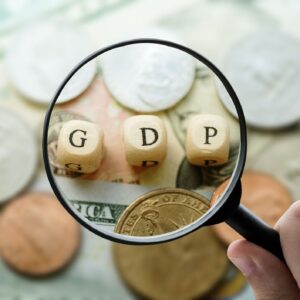In the past week I have seen two articles in The Wall Street Journal, one pro-tariff and one anti-tariff, which both ask a basic question: If tariffs are so bad, why have we not fallen into a recession?
Never mind that the rule-of-thumb definition of a recession has historically been “two quarters in a row of negative GDP growth,” and that the initial tariff announcements were made only one quarter ago, then delayed for 90 days. I realize that, in these days of our 24-hour news and social media noise storm, three months can seem like three years – but in reality, this past April was just a little more than 90 days ago.
Last week we received a surprisingly high first estimate of second-quarter GDP growth of 3 percent, which some touted as proof positive of the wonderful impact of tariff policy. Then we received a very poor jobs report, which others touted as proof positive that government data is rigged and can’t be trusted (except the GDP number we liked, of course).
There are plenty of people now explaining how government data is compiled: first releases are always estimates, and data continues to be collected. Revisions happen all the time, and in some cases, years later. What people are not talking about as much is important: How does the economy grow at 3 percent and yet create so few jobs?

The answer to both comes with context, something we seem to lack the patience for these days. The economy growing at 3 percent was driven by an extremely low import number. The context here is that this 3 percent reading was preceded by a reading of negative 0.5 percent. In other words, when one simply looks at the data, then the economy shrunk by 0.5 percent in the first quarter, then grew by 3 percent in the second quarter. If all one did was average those two quarters, then he could see that growth in the first half of 2025 was an anemic 1.25 percent. That is not a recession, but it isn’t good either.
The wild swing in GDP is driven by international trade. Imports are subtracted from the math of the GDP calculations for reasons we have discussed before. There was an enormous influx of imports in the first quarter as many consumers and companies stocked up on international goods in fear of potential tariffs making them more expensive. There was then an enormous decline in imports the second quarter as those previously imported goods were used instead. Less discussed in the second quarter estimate has been the negative from a drawdown in inventories.
All of this simply leads to the conclusion that all data must be viewed in context and no single report tells the whole story. This is doubly true for the employment situation report. Even prior to the revisions, which have been attacked, the economy was on a downward trajectory in terms of new jobs being created. For most of my career, the thought has been that we needed the economy to add 200,000 jobs every month to keep the unemployment rate steady; this amount simply kept up with growth in population and turnover. In the last 24 months, the economy has added that many jobs only six times. Put differently, the economy failed to add 200,000 jobs in 18 of the last 24 months.
The economy is slowly losing steam, and we can kill the messenger if we wish, but that does not change reality. We are not in recession, but we are not growing fast enough to add sufficient jobs.
What does this mean for investors? The relationship between the stock market and the economy is loose at best. In the short run stocks move on headlines and emotions, and in the long run they reflect the earnings of the companies. While the economy has been slowing, corporate earnings are still growing nicely. It is too early this earnings season for any meaningful conclusions, but so far so good. AI is real and the demand for AI investment is just going to grow. It is already helping some companies grow productivity, which will help produce earnings growth even if revenues slow. We are cautiously optimistic, but more cautious than we were a few months ago.
It could all improve if the tariff situation settles down. It would not hurt for the Fed to lower rates (more to come on that), but in my view they are late to act. Meanwhile, we can avoid the madness by keeping reports in context, accepting reality for what it is even if we don’t like it, and focusing on what really matters, which are the companies we own and their actual businesses.
Warm regards,

Chuck Osborne. CFA